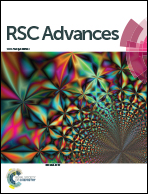Nanoporous polymer scaffold-embedded nonwoven composite separator membranes for high-rate lithium-ion batteries†
Abstract
The never-ceasing pursuit of high-energy/high-power lithium-ion batteries, which have garnered a great deal of attention particularly in (hybrid) electric vehicle and grid-scale energy storage system applications, is having with serious issues related to the performance deterioration and safety failures of cells. Herein, to overcome these challenges, we demonstrate a new class of three-dimensionally interconnected, nanoporous poly(vinylidene fluoride–hexafluoropropylene) (PVdF–HFP) scaffold-embedded polyethylene terephthalate (PET) nonwoven composite separators (referred to as “SF-NW separators”) as a microporous membrane-based approach. Motivated by unique porous structure based on inverse replicas of densely-packed nanoparticle arrays, sacrificial colloidal silica (SiO2) template-mediated nanoarchitecturing is exploited to fabricate SF-NW separators. The selective removal of SiO2 nanoparticles dispersed in PVdF–HFP matrix allows for the formation of a nanoporous PVdF–HFP scaffold in a PET nonwoven, where the PET nonwoven acts as a compliant porous substrate providing mechanical/thermal stability. The nanoporous structure of SF-NW separators is fine-tuned by varying the SiO2/PVdF-HFP composition ratio. Owing to the highly-developed nanoporous PVdF–HFP scaffold, the SF-NW separator shows facile ionic transport and excellent electrolyte wettability; thus, contributing to the superior cell performance (particularly at high charge/discharge current densities) in comparison to conventional polyolefin separators.


 Please wait while we load your content...
Please wait while we load your content...